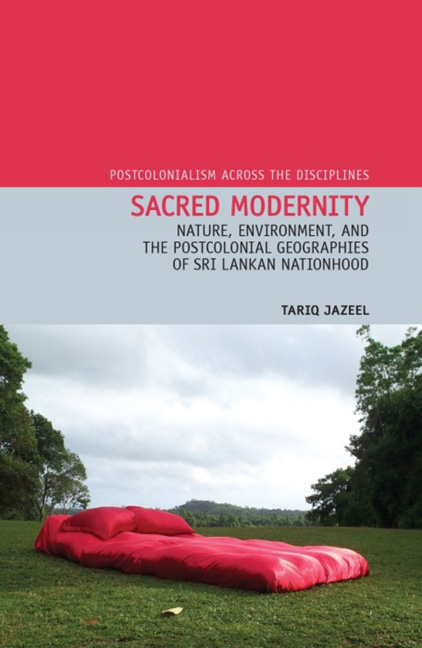Book contents
- Frontmatter
- Dedication
- Contents
- List of Map and Figures
- Acknowledgements
- Introduction
- 1 Sacred Modernity: Nature, Religion, and the Politics of Aesthetics
- Part I Ruhuna (Yala) National Park
- 2 Landscape, Nature, Nationhood: A Historical Geography of Ruhuna (Yala) National Park
- 3 Inscription and Experience: The Politics and Aesthetics of Nature Tourism
- 4 Political Geographies: Promoting, Contesting, and Purifying Nature
- Part II Tropical Modern Architecture
- Conclusion: Sri Lankan Nature as Problem Space
- Bibliography
- Index
3 - Inscription and Experience: The Politics and Aesthetics of Nature Tourism
from Part I - Ruhuna (Yala) National Park
- Frontmatter
- Dedication
- Contents
- List of Map and Figures
- Acknowledgements
- Introduction
- 1 Sacred Modernity: Nature, Religion, and the Politics of Aesthetics
- Part I Ruhuna (Yala) National Park
- 2 Landscape, Nature, Nationhood: A Historical Geography of Ruhuna (Yala) National Park
- 3 Inscription and Experience: The Politics and Aesthetics of Nature Tourism
- 4 Political Geographies: Promoting, Contesting, and Purifying Nature
- Part II Tropical Modern Architecture
- Conclusion: Sri Lankan Nature as Problem Space
- Bibliography
- Index
Summary
The silhouette of an elephant-black
Against the darkening gray.
The mongoose crawls along the road
At a leisurely pace.
Still calmness stands alongside the trees.
The sky darkens.
Darkness envelopes all around.
All is still.
One with the universe.
Kusum Disanayaka, ‘Dusk at Yala’, The Island, 8 August 1992Upon entering Block I of Ruhuna National Park, visitors pass through a gate upon which is a portal inscription. Yellow letters painted on a dark green board announce that:
Through these gates you enter a Protected area. The animals, birds, trees, the water, the breeze on your face and every grain of sand, are gifts that nature has passed on to you through your ancestors so that you may survive. These gifts are sacred and should be protected. Whisper a silent prayer as you pass through for the protection of wilderness around you and ensure that what you see and feel is passed on to the unborn generations to come.
From hereon in, the expectation and excitement of encountering at any moment a wild elephant, leopard, or sambhur emerging from its natural habitat becomes somehow indissoluble from the feeling that one has stepped into a sacred place, rich in history. Encounters with wild animals (Figure 2.1) are savoured, photographed. Animal behaviour is keenly observed, later explained by the trekker. Throughout tours of the park, visitors are struck by the tranquil aesthetics that seem to seep from its succession of different natural landscapes: flat plains dotted with grazing buffalo; thick, boggy scrub jungle; sand dunes and rocky outcrops where leopards bask; or glassy green lakes dotted with cormorants.
Most visitors will also stop to visit some of the Park's rich archaeological landscapes: Situlpahuwa, Magulmahavihara, or Akasachetiya, for example. At the rock outcrop Akasachetiya, the summit is reachable by a short, steep twenty-minute climb. Here there is a small pool in which Lotus flowers bloom next to the ruins of a Buddhist dagoba just a few metres high, dating back to the second century BCE, and there are breathtaking views, the elevation offering a sense of Ruhuna National Park's territory. In the distance, the gleaming white towers of the restored Situlpahuwa temple complex, which receives some 50,000 Buddhist pilgrims each year, are clearly visible.
- Type
- Chapter
- Information
- Sacred ModernityNature, Environment and the Postcolonial Geographies of Sri Lankan Nationhood, pp. 47 - 71Publisher: Liverpool University PressPrint publication year: 2013



